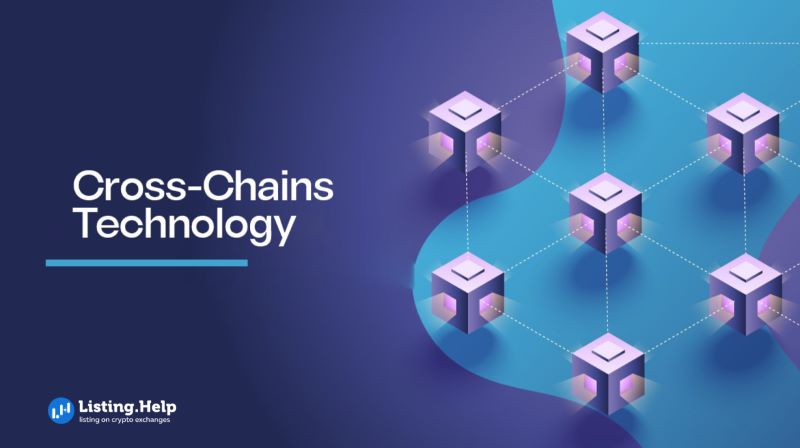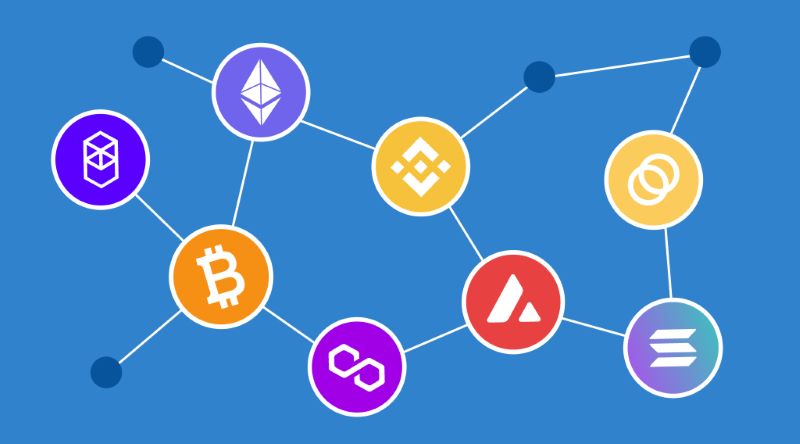Ever felt stuck with your crypto on one blockchain, unable to hop over to another? What is cross-chain, you ask? It’s the tech that smashes those walls down, letting assets flow freely between different blockchains. No more locked up tokens or coins! Soon you’ll see how this game-changer can mean big things for your digital wallet. Let’s dive straight into the nuts and bolts of it all.
Understanding the Fundamentals of Cross-Chain Technology
Defining Cross-Chain Communication and Its Importance
Have you ever wished your digital money could move freely between different blockchains? That’s where cross-chain communication steps in. It’s like a language translator for various blockchain networks. It lets you send and receive assets across different blockchains. Why is this so crucial? Imagine going to a foreign land and speaking only your native tongue; it’s tough to get around, right? Just like that, blockchains need to ‘talk’ to each other to share assets and data smoothly.
The magic behind this is cross-chain technology. It opens up a world of options. You aren’t stuck on one blockchain. With it, you can tap into the full potential of decentralized finance. You get to use the best features from multiple blockchains, all at once. This teamwork among blockchains can make everything more useful and valuable.
An Overview of Cross-Chain Protocols and How They Work
Now, let’s dive into cross-chain protocols. How do they work? Think of cross-chain protocols as bridges. These bridges connect islands, which are like separate blockchains. They let people cross back and forth, carrying their assets with them. These ‘bridges’ come in different forms. You might have heard of cross-chain bridges or atomic swaps.
Cross-chain bridges have a simple goal. They move assets and info from one blockchain to another. Yet, they must be safe, just like real bridges. If not, assets could fall into the abyss. Atomic swaps are a cool trick of cross-chain tech. They let people swap different types of digital money directly. You can trade your digital coins with someone else’s without needing a middleman.
Multichain platforms are another vital part of this. They support these bridges and swaps. They keep things running smooth and scale up to meet user needs. And let’s not forget about token wrapping. It’s a process of representing tokens from one ledger onto another. It’s key to moving value between blockchains.
But cross-chain tech isn’t all fun and games. Challenges like security and keeping everything in order are tough nuts to crack. Builders of these techs work hard to make sure bridges are safe and everyone plays fair. They must agree on the rules, which we call cross-chain consensus.
Inter blockchain communication makes public networks (like Bitcoin) and private chains (like a company’s own blockchain) join hands. By working together, they can do much more. It’s like having friends in different cities who help each other out.
In the end, cross-chain solutions are reshaping the future of blockchain tech. They break down walls so everyone can work together. They give us a world where blockchains are not alone. They are part of a larger, connected community where assets sail smoothly between ports in the vast sea of digital finance.
The Role of Cross-Chain Bridges in Improving Blockchain Interoperability
The Mechanics of Cross-Chain Transactions
Cross-chain transactions are like magic tricks in the tech world. They let you send value over different blockchains. These blockchains don’t usually work together. But with cross-chain tech, they can. Think of cross-chain bridges like special roads. They connect two towns that couldn’t reach each other before. These bridges let assets travel safely from one place to another.
First, let’s break down how these transactions happen. It starts with two parties. Say, Alice wants to send money to Bob. But Alice’s money is on a different blockchain than Bob’s wallet. They use a cross-chain bridge. This bridge has rules, called protocols, to make sure the swap is fair.
These smart contracts are like robot judges. They hold onto Alice’s money until Bob’s chain confirms the deal. Only then does Bob get the money. This keeps things safe and trusty. Alice doesn’t have to worry about losing her money if something goes wrong.
One type of these swaps is called atomic swaps. They’re a fancy way to trade without a middle-man. You swap directly with someone else. It’s quick, cheap, and private. But it’s sort of complex. Not all blockchains can do atomic swaps yet.
The thing is, these bridges must be secure. Hackers are always trying to steal digital money. So the people who make bridges work hard to close any gaps that hackers might use. They also try to make sure the bridge can handle a lot of traffic. A busy bridge is great, but if it’s too slow or costly, people won’t use it.
Case Studies: Successful Implementations of Cross-Chain Bridges
Now let’s talk about times when cross-chain bridges really helped out. There are famous cases in the DeFi world. These cases show how cross-chain can change the game.
One such project is Polkadot. They let different chains chat and share information. It’s like different computers talking the same language. Another example is Cosmos. They’ve made a big network where each blockchain is like a star in a huge galaxy.
Then there’s Wrapped Bitcoin (WBTC). It’s like taking a gold bar (Bitcoin) and turning it into lots of little gold coins (on Ethereum). This lets Bitcoin join in on the DeFi fun in the Ethereum world.
These cases are cool because they show what’s possible. They give us a peek into a future where all blockchains can get along. This could mean easier and cheaper ways for everyone to use digital money. It’s not just about trading either. It’s about new and fun ways to use money online.
Each case helps solve big questions in cross-chain tech. They help figure out how to talk across chains, move assets, and keep things safe. And the more we study these cases, the better bridges we can build tomorrow.
Enhancing DeFi with Cross-Chain Solutions
Exploring the Impact of Atomic Swaps in Decentralized Finance
Atomic swaps change how we trade. No middlemen are needed. It’s trading made easy. These swaps let you exchange coins straight from your wallet. This means you don’t have to rely on a third party to hold your coins when making trades. In DeFi, atomic swaps are a big deal. They make it possible to switch different types of digital money without any hassle.
Think of it like trading cards with a friend. You agree to swap one card for another. Once you both say yes, the trade happens instantly. With atomic swaps, it’s similar. You agree to swap currencies. If all the computer codes match up, the swap happens. It works across different blockchains. So, you can trade Bitcoin for Ethereum, without using an exchange. This is part of what we call cross-blockchain operations.
Atomic swaps help make DeFi platforms better. They do so by offering more freedom in trading. They cut the need for trusted third parties. And they make trading quick and cheap. But, it’s not all perfect. Building secure and smooth atomic swaps is tough. We have to be sure that no one tries to cheat the system.
Cross-Chain Smart Contracts and Their Applications in DeFi Platforms
What about, cross-chain smart contracts? They work like a normal contract but run on the blockchain. They help with things like loans and trade on DeFi platforms. The cool part is, they can work across different blockchains. For example, you could have a smart contract that works with both Ethereum and Binance Chain. That’s what we call interoperable blockchain networks.
These contracts allow DeFi platforms to grow. They can offer new services across different chains. As a result, platforms become more useful to you and me. We can do more without leaving the blockchain we trust. This is part of the larger picture of blockchain interoperability.
But, like with swaps, it’s not easy. Making these contracts safe and fast is hard work. Still, as we solve these issues, DeFi gets even better. It becomes more open and offers more opportunities to everyone.
To sum it up, cross-chain solutions in DeFi like atomic swaps and smart contracts are changing the game. They let us trade and make deals without waiting or paying high fees to middlemen. With smarter tech, our digital wallets can do more for us. They break down walls between different blockchains. And they make our DeFi experience smoother and more powerful. It’s all about creating a world where all blockchains can talk to each other. And we’re making it happen, one swap and one smart contract at a time.
Overcoming the Challenges: Scalability, Security, and Governance in Cross-Chain Integration
Addressing Security Concerns in Cross-Chain Exchanges
Cross-chain tech lets us send data and money across different blockchains. But, with big leaps come big risks. Imagine you send a digital token to another blockchain. It must be safe, right? Well, it has to get past many threats. Hackers and bugs can take a shot at it. They can cause trouble during swaps or steal assets.
What do we do to tackle these issues? We use clever math and code to lock down security. Just like building a bank vault, we create secure codes that only let the right person in. This way, we make sure that when tokens travel across chains, they arrive safe and sound.
Security needs round-the-clock work. We constantly test and improve our tech. With each fix and update, we make the system stronger. It’s like a digital immune system. We always need to keep ahead of the bad actors.
The Evolution of Cross-Chain Governance and Consensus Mechanisms
Now, let’s talk about who makes the rules and how they’re set. That’s governance. In the cross-chain world, it’s tricky. Why? Because many players are involved, each with different goals. They range from solo traders to big companies. They’re like a diverse crowd, each singing a different tune.
To make music, not noise, we need harmony. That’s where governance comes in. It decides what’s fair play. It sets rules that everyone follows. It’s a bit like having a ref for a game. The ref makes sure everyone plays fair.
But how do we all agree on the rules? That’s consensus. It’s a way to make decisions as a group. Think about friends picking a game to play. They talk it over until they figure it out. That’s what blockchains do in their own way.
When we link chains, the game changes. More choices, more players. So we craft new ways to reach agreement. It’s always evolving, always growing. Like kids learning new games and making up rules as they go.
Cross-chain tech is here to make blockchain better. We face hurdles like keeping it secure and agreeing on the rules. But we work hard to clear these hurdles. We want a world where blockchains shake hands and share freely. That’s the future we’re building – one block at a time.
In this post, we dug into the nuts and bolts of cross-chain tech. We saw how it lets different blockchains talk to each other, making everything more connected. We learned about the protocols that power this and how important they are.
We also looked at cross-chain bridges, which let us do deals across various blockchains. We checked out real examples of where this worked out great.
Next, we explored how cross-chain tools boost DeFi, making it even cooler with atomic swaps and smart contracts. These tools let us trade and use services across different platforms without sweat.
We ended by tackling big issues like making sure these cross-chain deals are safe and how to manage them well.
All in all, cross-chain tech is a big deal for blockchain. It fixes a lot of headaches by letting different blockchains work together. It’s not perfect yet, but the smarts and hard work going into it are paving the way for an even better digital future. Keep an eye on this space – it’s moving fast, and there’s more cool stuff to come.
Q&A :
What exactly does “Cross-chain” refer to in blockchain technology?
Cross-chain technology is a concept that refers to the interoperability between two or more independent blockchains. This allows for the exchange of information and value, letting users transact across different blockchain networks without the need for intermediaries. This can include transferring assets, data, or executing smart contracts across distinct chains.
How does cross-chain communication benefit users?
Cross-chain communication offers numerous benefits to users, including increased flexibility and access to a wider range of decentralized applications. It reduces the need for swapping tokens on exchanges, thereby saving on transaction fees and time. Furthermore, it enhances the overall liquidity in the crypto ecosystem and allows for the creation of more interconnected, innovative blockchain applications.
Are there different types of cross-chain transactions?
Yes, there are several types of cross-chain transactions, including atomic swaps, which is a direct exchange of currencies between different blockchains, and cross-chain bridges, which are protocols designed to connect two blockchains. Additionally, sidechain methods allow assets to be pegged on one blockchain and used within another.
What are the main challenges with cross-chain technology?
The main challenges with cross-chain technology include security issues, such as the risk of smart contract vulnerabilities and the potential for network attacks during transactions. Scalability is also a concern, as high transaction volumes could lead to congestion. Additionally, achieving true interoperability between vastly different blockchain architectures requires complex solutions.
Is cross-chain the future of blockchain interoperability?
Many experts believe that cross-chain technology is a pivotal step towards achieving broad interoperability in the blockchain space. By allowing seamless interactions between different networks, it has the potential to unlock unprecedented collaboration and innovation. While it is still in its early stages, continued development and adoption could render cross-chain solutions a key component of the blockchain ecosystem’s future.





